|
Limitar tu búsqueda
[+–] Creator
- Aguayo Tellez, Ernesto (2)
- Aguilera, Nelly (7)
- Amuedo Dorantes, Catalina (2)
- Ayala Gaitán, Edgardo A. (2)
- Benavides, Guillermo (2)
- Blair, Randall (2)
- Calderón-Madrid, Angel (2)
- Calónico, Sebastián (1)
- Camillo Rosati, Furio (2)
- Campos Vázquez, Raymundo M. (2)
- Campuzano, Larissa (2)
- Castellanos, Sara G. (2)
- Coello Levet, Carlo G. (2)
- Cruz Rivero, Carlos (2)
- Cuilty, Emilio (2)
- De la Torre, Rodolfo (4)
- Gameren, Edwin van (2)
- García Moreno, Vicente (2)
- Heimann, Ursula (2)
- Hernández Ángeles, Domingo F. (2)
- Hu, Chiung-Yin (1)
- Huidobro Ortega, Alberto (4)
- Hysenbegasi, Alketa (1)
- Jarillo Rabling, Brenda (2)
- Le Thi, Mai Linh (2)
- Levy, Dan (2)
- Lima, Martín (2)
- Luna Ruiz, Gabriela A. (2)
- López Rodríguez, Patricia (3)
- López-Calva, Luis Felipe (1)
- Manuel Gutiérrez, Diana (2)
- Martin, Philip (1)
- Martinez, Jose (2)
- Martínez Cárdenas, Rubén (2)
- Martínez, Gabriel (6)
- Merino Sanz, María (2)
- Miranda, Martha (5)
- Morales Barrera, Raquel (2)
- Morales, F. Javier (2)
- Moreno, Lorenzo (2)
- Muñoz Izquierdo, Carlos (2)
- Navarrete Luna, Juan (2)
- Negrín, José L. (2)
- Ocampo, Diadelfa (2)
- Orcí, Sandra (2)
- O’Keefe, Mary (2)
- Patrinos, Harry Anthony (2)
- Pozo, Susan (3)
- Pérez Yarahuán, Gabriela (2)
- Ramírez Medina, Edgar (2)
- Robison, Lindon J. (1)
- Rossi, Mariacristina (2)
- Sana, Mariano (1)
- Sandoval, Héctor H. (2)
- Santibáñez, Lucrecia (2)
- Santos, María Emma (1)
- Schreiner, Mark (2)
- Scott, John (4)
- Siles, Marcelo E. (1)
- Sinha, Tapen (2)
- Soloaga, Isidro (3)
- Torán, Mariana A. (2)
- Vaca Domínguez, Beatriz (2)
- Vargas Chanes, Delfino (2)
- Velázquez, César (2)
- Woodruff, Christopher (2)
- Zapata Álvarez, Gabriela (2)
- Zaragoza Castillo, Ricardo (2)
- de la Cruz, Paúl (2)
- de la Fuente, Alejandro (2)
- Álvarez, Jesús (2)
- Ñopo, Hugo (1)
[+–] Editorial
[+–] Fecha
[+–] Formato
[+–] Idioma
[+–] Tipo de documento
[+–] Tipo de recurso
[+–] Classification
|

|
|
Seguridad social y desigualdad en México: de la polarización a la universalidad
El artículo documenta el fracaso de la seguridad social en México como instrumento de protección social y evalúa posibles estrategias de reforma. Se analiza la cobertura truncada para la población más vulnerable, la incidencia regresiva y desigualdades horizontales de los subsidios públicos a la seguridad social, y las consecuencias para la pobreza en adultos mayores y la desigualdad en...
|

|
|
|
|

|
|
Book review. Improving the quality of education in Mexico: Positions and proposals, edited by Francisco Miranda, Harry Patrinos y Ángel López
This book gathers analyses performed by several authors on policies considered appropriate by the World Bank to enhance the quality of basic education provided in Mexico, in particular, education received by majority sectors in our society (World Bank: 2005).
|

|
|
|
|

|
|
An investigation into the cost of universal health coverage in Mexico
The Mexican social security system, after operating for over six decades, has managed to provide healthcare for slightly over half the resident population.
There are wide geographical and socioeconomic variations in coverage. To provide wider coverage, the Federal Government created the Sistema de Protección Social en Salud (SPSS) for covering low income family. It becomes the third...
|

|
|
|
|

|
|
Book review. Public policy for an inclusive growth, edited by Pablo Cotler
The book “Public Policy for an Inclusive Growth” (The book) is an opportune and fortunate document. It is opportune because it is presented at a time in which public policy topics are subject to a wide debate in Mexico, and the discussion is fed with diverse points of view, theoretical and political, from which it is the purpose to analyze, design, redesign, implement, and evaluate the government...
|
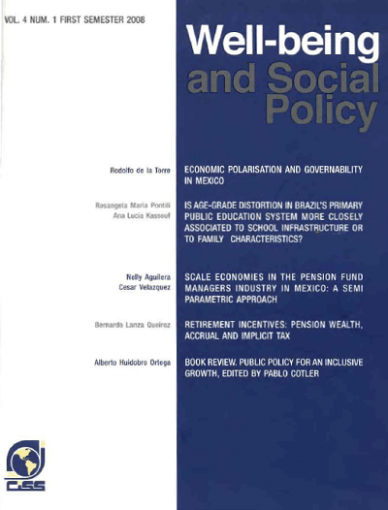
|
|
|
|

|
|
Scale economies in the pension fund managers industry in Mexico: a semi parametric approach
It has been widely accepted that reforms on pension schemes have led to improvements in the financial viability of the systems. Nevertheless, at the same time it has been shown that fees charged by pension fund managers (PFM) are very high, implying high mark-ups for them and lower expected pensions for the participants. The presence of economies of scale has been suggested as one main reason for...
|
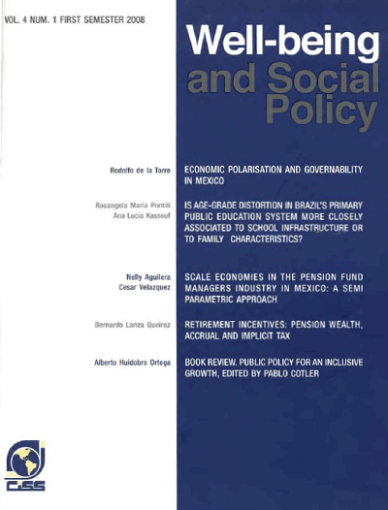
|
|
|
|

|
|
Economic polarisation and gobernality in México
The purpose of this essay is to appraise alternative hypothesis about the origins of recent social revolt in Mexico. It shows that it is not clear that a severe rise in poverty preceded the origins of violent conflict but social polarisation. Therefore, government attempts to deactivate the economic factors that led to social unrest did not necessarily upgrade povertyreduction policies. The...
|

|
|
|
|

|
|
Conflict and power: the teachers' union and education quality in Mexico
The teachers union in Mexico, or Sindicato Nacional de Trabajadores de la Educación (SNTE) represents over 1 million members and is the largest in Latin America. This study uses data from the national student tests administered by the Instituto Nacional para la Evaluación de la Educación (INEE), along with data from the Mexican Ministry of Education and other sources, to investigate the...
|
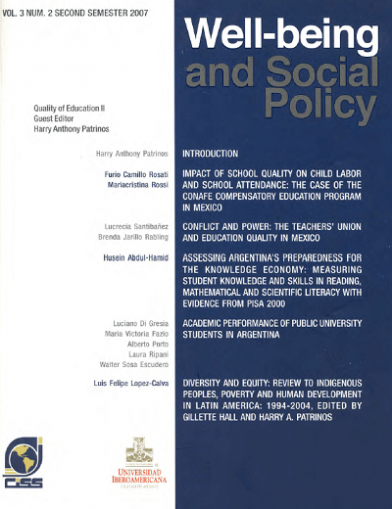
|
|
|
|

|
|
Impact of school quality on child labor and school attendance: the case of the CONAFE compensatory education program in Mexico
This paper focuses on the impact that two different types of policy interventions, namely enhancing school quality and contingent cash transfers, have on child labor and school attendance in Mexico. While there are many studies on the impact of Oportunidades on schooling outcomes, little evidence is available on whether school quality programs such as CONAFE also reduce child labor and help keep...
|

|
|
|
|

|
|
Institutional effects as determinants of leaning outcomes: exploring state variations in Mexico
We use the PISA 2003 student-level achievement database for Mexico to estimate state education production functions. Student characteristics, family background, home inputs, resources and institutions are controlled for. We take advantage of the state-level variation and representative sample to analyze the impact of institutional factors such as state accountability systems and the role of...
|

|
|
|
|

|
|
Introduction of basic accounts in Mexico to address the issue of access to the banking system: design and expected impact
This article presents the Mexican experience with the introduction of basic transaction accounts. Basic accounts are relatively cheap simple banking products with restricted functionality targeted at social groups that have limited access to transaction accounts. In Mexico, basic payroll accounts and accounts for the general public were introduced. By law, these products must be offered by all...
|
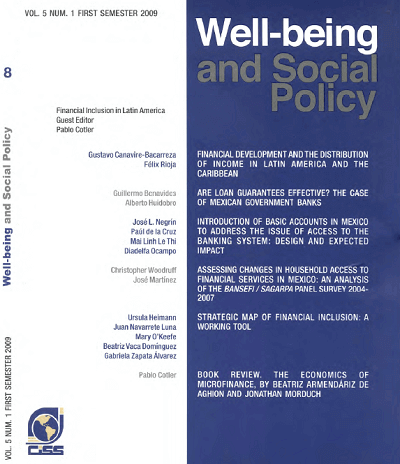
|
|
|
|

|
|
Workers' remittances and currency crises
We seek to further understand the factors that determine per emigrant remittances using data from 23 Latin American and Caribbean countries over the 1980-2003 period. We find that emigrants avoid remitting when the exchange rate is under pressure. This finding is consistent with the notion that remitters strive to reduce their exposure to exchange rate losses by taking into account the expected...
|
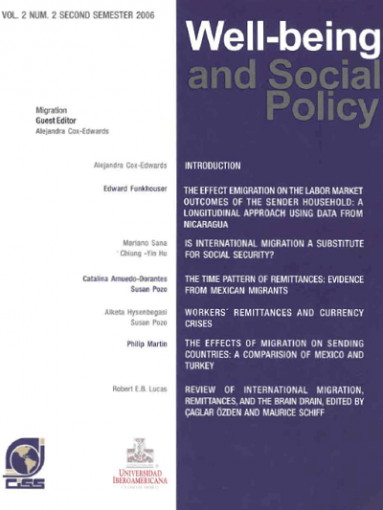
|
|
|
|

|
|
The time pattern of remittances: evidence from mexican migrants
We explore the time pattern of remittances using data on return migrants from the Mexican Migration Project. Some of these return migrants have settled in the U.S. and are returning to Mexico to visit family and friends, whereas others are temporary migrants returning home after a working spell in the U.S. We find that the dollar amount remitted first increases with time spent in the U.S. to...
|
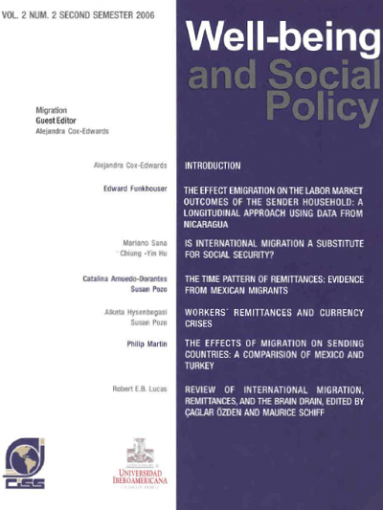
|
|
|
|

|
|
Catastrophic expenditure in health and income elasticities by item of expenditure in health services in Mexico
The objective of this article is to put in economic perspective the expenditure in health within the pattern of family expenditure of the Mexican households. Information of the National Survey on Income Expenditure of Households (ENIGH) of Mexico of 2004 is analyzed on: structure of the expenditure of the households, expenditure in health and income-expenditure elasticities in health; by...
|
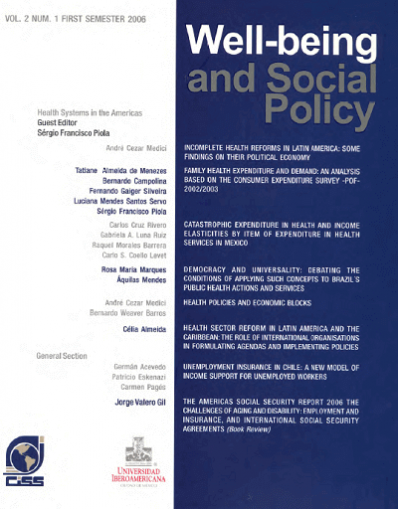
|
|
|
|

|
|
Social security and inequality in Mexico: from polarization to universality
The article documents the failure of social security in Mexico as an instrument of social protection and evaluates possible reform strategies. It analyses the truncated coverage of these systems for the most vulnerable, the regressive incidence and horizontal inequities of public social security subsidies, and the consequences for old-age poverty and inequalities in basic health opportunities. It...
|

|
|
|
|

|
|
Seguro social de salud
El gobierno de México definió entre los años noventa y los dos mil principios de reforma a los seguros de salud e intentó implementarlos. Las principales iniciativas aprobadas definieron esquemas voluntarios, en un caso basado en aseguradoras privadas (que tienen muy baja penetración), y en otro, en una nueva instancia pública que funciona como mecanismo de distribución del gasto federal hacia...
|
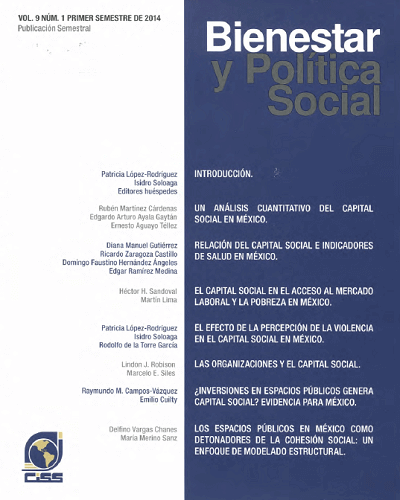
|
|
|
|

|
|
Programas de pensiones, empleo y familia
Los programas de pensiones, empleo y familia constituyen tres de las cuatro grandes categorías de la política social (la cuarta siendo los de salud). En este artículo se analizan opciones para su diseño dentro de un marco de universalidad de la seguridad social en México. Si bien estos programas tienen componentes de beneficios monetarios centrales, también requieren de estrategias sólidas y...
|
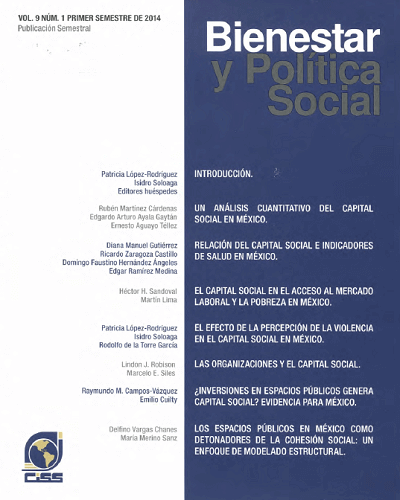
|
|
|
|

|
|
Are loan guarantees effective? The case of mexican government banks
Mexican Government’s Banks offer loan guarantees to private banks in order to spur credit directed to non-financial small and medium sized firms and this policy is examined here. Application of representative data to the comparative static analysis of the guarantee-use decision suggests that these schemes, as currently designed, are justifiable from an economic viewpoint. However, there is some...
|
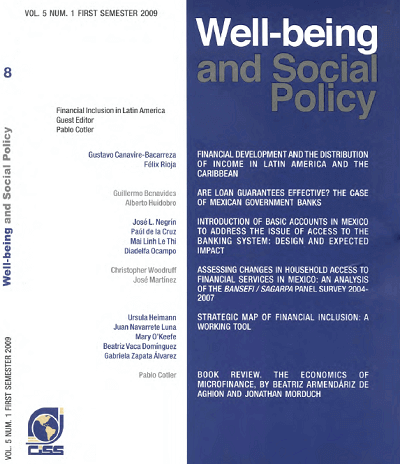
|
|
|
|

|
|
Assessing changes in household access to financial services in Mexico: an analysis of the BANSEFI/SAGARPA panel survey 2004-2007
In March 2004, BANSEFI and SAGARPA began a project to examine the impact on households I of the Program to Strengthen the Popular Credit and Savings Sector (Programa de Fortalecimiento del Sector de Ahorro y Crédito Popular), which was designed to help non-bank financial intermediaries to abide by the Ley de Ahorro y Crédito Popular (LACP), passed by the Mexican Congress in 2001. During the...
|
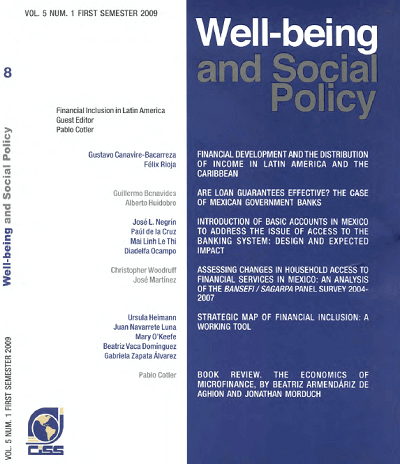
|
|
|
|

|
|
Introducción (sobre los sistemas de protección social que se aborda en el presente número de la revista)
La construcción del estado de bienestar en México inició en torno a los años de la Gran Depresión y la Segunda Guerra Mundial, como una gran movilización nacional que a su vez formó parte de un compacto global para mejorar las normas laborales y establecer sistemas nacionales de seguridad social. La Conferencia Interamericana de Seguridad Social se fundó en 1942 en apoyo a ese movimiento. En este...
|

|
|
|
|

|
|
Social security pensions and retirement decisions in Mexico
Using Mexican cohort data for 1991-2000 this article examines the relationship between retirement decisions —the transition from work to labor market inactivity— and social security (contributive) pensions in less developed countries. The available large time series also makes possible to examine how a financial crisis that took place in 1995 has affected retirement incentives. In most Latin...
|

|
|
|
|
|